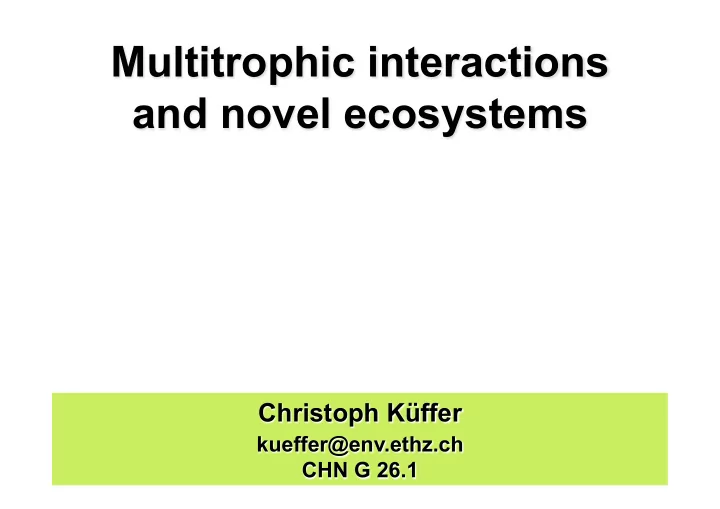

Multitrophic interactions and novel ecosystems Christoph Küffer kueffer@env.ethz.ch CHN G 26.1
Overview A. Novel ecosystems and trophic impoverishment B. Multitrophic interactions: some basics
Novel ecosystems and trophic impoverishment
Novel ecosystems ‘Novel ecosystems’ have species compositions and relative abundances that have not occurred previously within a given biome. The key characteristics are: (1) novelty: new species combinations, with the potential for changes in ecosystem functioning (2) human agency: ecosystems that are the result of deliberate or inadvertent human action, but do not depend on continued human intervention for their maintenance. Hobbs et al. Global Ecology and Biogeography, 2006
What is the role of biotic change for (anthropogenic) ecosystem change?
Novel ecosystems Hobbs & Cramer, Ann. Rev. Env. 2009
Alternative stable states: plant-soil feedbacks For instance invasion of N-fixing non-native species such as Morella [Myrica) faya in island ecosystems (e.g. Hawaii Volcanoes National Park). These species increase soil fertility and thereby facilitate further invasions by other non-native species (“invasional meltdown”)
Alternative stable states: fire cycles For instance invasion of fire-tolerant and fire-enhancing non-native species in habitat without a long history of fires and thus no native fire-adapted species
Novel multitrophic interactions?
Trophic impoverishment of Europe’s fauna Wolf Lion Bear Wild cat Lynx European mink Fish otter Wisent (European bison) Moose Aurochs Wild horses
The loss of mega-frugivores in past < 50k years 7580 kg 300 kg 100 kg (9 kg) 0.54 kg (0.009 kg) Hansen & Galetti, Science, 2009
Loss of marine megafauna sharks increased anthrop. disturbances Ferretti et al., Ecology Letters 2010
Loss of marine megafauna sharks Springer al., PNAS 2003
Loss of marine megafauna Jackson, PNAS 2001
Loss of marine megafauna Jackson, PNAS 2001
?? insects (DDT) flightless ?? alien, naturalized insects 3 snakes Dodo 10 alien, nat. reptiles giant & grey parrot 20 alien, nat. birds 2 giant tortoises Mauritius owl, harrier 2 rats, mouse, dog, shrew, feral cats, 1865 sq km giant lizard mongoose, tenrec feral pig 2 fruitbats monkey deer, goat, hare, rabbit Cheke & Hume, Lost Land of the Dodo, 2008
Multitrophic interactions: some basics
Tri-trophic interactions and trophic cascades
Predator-herbivore-plant predator wolf-deer-forest extreme climate events lynx-snow hare African savannah consumer tropical forests (Terborgh’s islands) otter-urchin-kelp primary abiotic biological control producer resources bottom-up v. top-down control?
Avoidance / tolerance behavior predator flocking behavior nocturnal activity consumer habitat use patterns increased plant defense switch in vegetation composition primary producer R. hawaiiensis alien Rubus
to eat costs Townsend et al., Ecology, 3rd edition, 2008
Consumer - producer coevolution: consumer change induces producer change (1/2) enemy release hypothesis Keane & Crawley TREE, 2002
Consumer - producer coevolution: consumer change induces producer change (2/2) Lambers et al. Plant Physiological Ecology, after: Rhoades, Am Nat. 1985 Phenotypic response (e.g. enemy release) or genetic response (evolution of increased competitive ability, EICA)? Blossey & Nötzold J Ecology, 1995
Consumer - producer feedback: producer change induces consumer change infertile vegetation fertile vegetation low-quality litter high-quality litter SOIL fungi bacteria fungal-feeding fauna (“grazing”, bacteria-f. fauna (“predation”, e.g. collembolans or mites) e.g. protozoans or nematodes) predatory fauna predatory fauna
Predator-mesopredator-prey “mesopredator release” alien native cat or fox dingo alien alien rat cat or fox native native marsupials seabirds
more than one species on a trophic level apparent alien native competition cat or fox dingo + + alien - - alien rat cat or fox native native marsupials seabirds
bushmeat hunting and fish supply in West Africa Brashares et al., Science, 2004
trophic interactions in the landscape mountain pigmy possum bogong moth
plant-animal mutualisms
cascading effects of extinction of mutualist Reproduction of an endemic shrub in New Zealand without (on rat- infested mainland) and with (on rat-free islets) pollinating bird species Anderson et al., Science, 2011
competition for higher trophic levels Number of pollinators visiting Raphanus flowers at different densities of Cirsium flowers. Ghazoul, J Ecol, 2006
From food chains to food webs Bascompte et al. Science, 2009
Network analysis (1/2) Rarity of interactions (k) Bascompte & Jordano, Annu. Rev. Ecol. Evol. Syst., 2007
Network analysis (2/2) Nestedness analysis Randomness of distribution of interactions between species
The diversity - stability debate Haldane & May, Nature, 2011 May 1973 http://www.multimedia.ethz.ch/conferences/2009/latsis
Recommend
More recommend